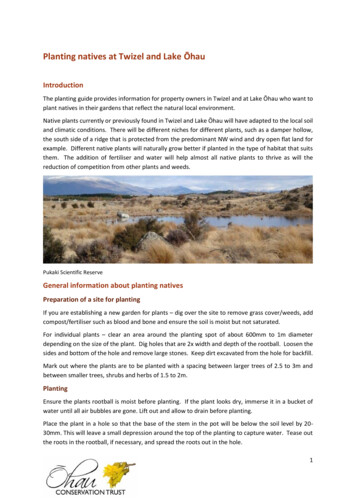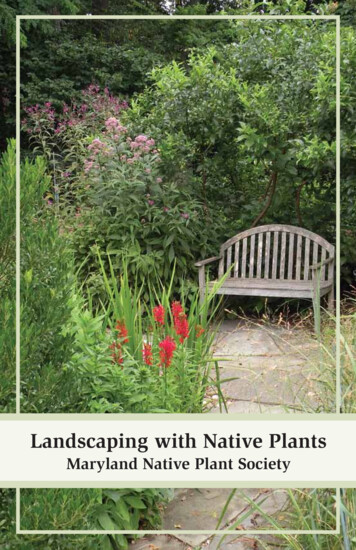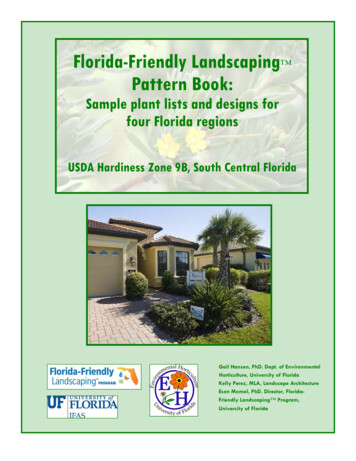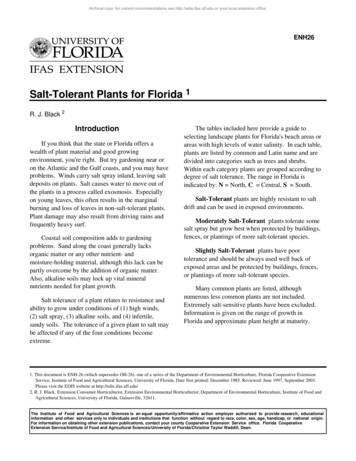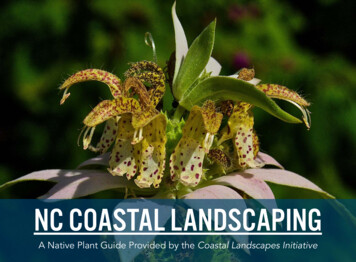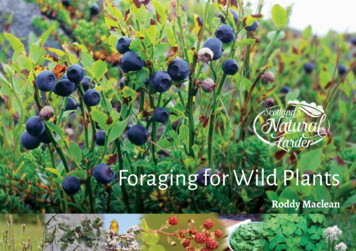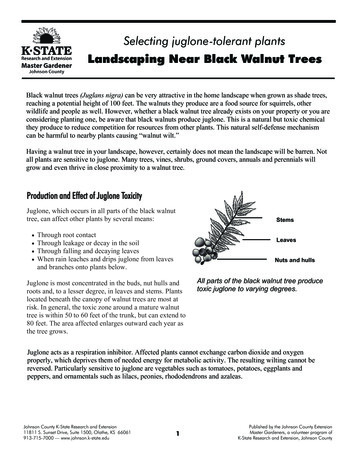
Transcription
Selecting juglone-tolerant plantsLandscaping Near Black Walnut TreesBlack walnut trees (Juglans nigra) can be very attractive in the home landscape when grown as shade trees,reaching a potential height of 100 feet. The walnuts they produce are a food source for squirrels, otherwildlife and people as well. However, whether a black walnut tree already exists on your property or you areconsidering planting one, be aware that black walnuts produce juglone. This is a natural but toxic chemicalthey produce to reduce competition for resources from other plants. This natural self-defense mechanismcan be harmful to nearby plants causing “walnut wilt.”Having a walnut tree in your landscape, however, certainly does not mean the landscape will be barren. Notall plants are sensitive to juglone. Many trees, vines, shrubs, ground covers, annuals and perennials willgrow and even thrive in close proximity to a walnut tree.Production and Effect of Juglone ToxicityJuglone, which occurs in all parts of the black walnuttree, can affect other plants by several means:Stems Through root contact Through leakage or decay in the soil Through falling and decaying leaves When rain leaches and drips juglone from leavesLeavesNuts and hullsand branches onto plants below.Juglone is most concentrated in the buds, nut hulls androots and, to a lesser degree, in leaves and stems. Plantslocated beneath the canopy of walnut trees are most atrisk. In general, the toxic zone around a mature walnuttree is within 50 to 60 feet of the trunk, but can extend to80 feet. The area affected enlarges outward each year asthe tree grows.All parts of the black walnut tree producetoxic juglone to varying degrees.Juglone acts as a respiration inhibitor. Affected plants cannot exchange carbon dioxide and oxygenproperly, which deprives them of needed energy for metabolic activity. The resulting wilting cannot bereversed. Particularly sensitive to juglone are vegetables such as tomatoes, potatoes, eggplants andpeppers, and ornamentals such as lilacs, peonies, rhododendrons and azaleas.Johnson County K-State Research and Extension11811 S. Sunset Drive, Suite 1500, Olathe, KS 66061913-715-7000 — www.johnson.k-state.edu1Published by the Johnson County ExtensionMaster Gardeners, a volunteer program ofK-State Research and Extension, Johnson County
Gardening and Landscaping Near Black Walnut TreesSymptomsThe symptoms in plants sensitive tojuglone range from stunting, yellowing, topartial or total wilting, to complete death. Tomatoes show symptoms of yellow-ing and discoloration of the leaves, aswell as twisting and puckering. Discoloration and darkening of internalstem tissue can also occur. Walnut toxicity will result in completedeath in fast growing annual plantssuch as potatoes or tomatoes. Toxic reaction often occurs quickly.Highly sensitive plants can go fromhealthy to dead within one or twodays. For woody plants such as shrubs and trees, symptoms on new growth can be similar in appearance to thoseof annual plants Generally, the symptoms on older growth are more subtle and will appear as an overall decline of theplant, with eventual death possible. The effects of juglone toxicity sometimes mimic symptoms of various plant diseases and physiologicaldisorders.ControlsThere is no chemical control available to stop the potentially toxic effect of juglone. The only practical controlis physical separation. The best advice when gardening near black walnuts is to use caution. Understandingthe site to be landscaped or developed into a garden is the first step in assuring the survival of plantings. General tips for planting around black walnuts include: Garden location. Locate gardens well away from black walnuts. Raised beds. Create and plant in raised beds to reduce root contact. This will require lining the bed usingweed fabric and filling the raised bed with new amended soil. Clean up is important. Prevent twigs, branches, leaves, nuts, hulls, and stems from decomposing near plantingareas. Volunteer removal. Pull out walnut volunteer seedlings.Johnson County K-State Research and Extension11811 S. Sunset Drive, Suite 1500, Olathe, KS 66061913-715-7000 — www.johnson.k-state.edu2Published by the Johnson County ExtensionMaster Gardeners, a volunteer program ofK-State Research and Extension, Johnson County
Gardening and Landscaping Near Black Walnut Trees Mulch precautions. Do not use fresh black walnut leaves, bark and wood chips as mulch. Walnut bark can be usedfor mulch if it has been composted for a minimum of six months. Plant selection. Plant tolerant trees, shrubs, vines, ground covers, flowers and grasses under walnut trees, or inareas that might contain walnut trees. See the list on pages 4 to 5. Adding to your compost pile. You can compost walnut leaves because the toxin breaks down when exposed to air,water and bacteria. The toxic effect can degrade in two to four weeks. In soil, breakdown may take up totwo months. Is removal a solution? No. Cutting down the tree will not solve the problem for a long time because juglone canpersist in the wood until the roots are decomposed, which can take five years or more. Removing a walnuttree may not be practical when the tree is the focal point in a landscape. Soil improvement. Maintain high organic matter levels in the soil to improve drainage and to encouragehealthy soil microbial populations that can metabolize toxins.Plants Susceptible to JugloneThe following plants are observed to be susceptible to juglone produced by walnut trees. This list is based onlyon observation and experience, not scientific experiments. It should be used for guidance only, not regarded asdefinitive.TreesPipe Vine Aristolochia macrophyllaPotentilla cinquefoil Potentilla fruticosaPrivet Ligustrum vulgareFirethorn Pyracantha sp.Rhododendron Rhododendron sp.Viburnum (most) Viburnum sp.Yew Taxus sp.Alder, Alnus glutinosaApple/Crabapple Malus sp.Basswood (linden) Tilia americanaBirch, White Betula papyriferaChokeberry, Red Aronia arbutifoliaMagnolia, Saucer Magnolia x soulangianaMaple, Silver Acer saccharinumMountain Laurel Kalmia sp.Norway Spruce Picea abiesPine (most) Pinus sp.Russian Olive Elaeagnus angustifoliaOrnamental cherry cultivars PrunusAnnualsPetunia Petunia sp.Perennials and BulbsColorado Columbine Aquilegia caeruleaChrysanthemum Chrysanthemum morifoliumCoral bells Heuchera sp.ShrubsAmur honeysuckle Lonicera maackiiArborvitae Thuja occidentalisAzalea Rhododendron sp.Cotoneaster Cotoneaster sp.Hydrangea Hydrangea sp.Lespedeza Lespedeza striataLilac Syringa sp.Nine-Bark Physocarpus opulifoliusJohnson County K-State Research and Extension11811 S. Sunset Drive, Suite 1500, Olathe, KS 66061913-715-7000 — www.johnson.k-state.eduFruitBlackberry Rubus sp.Blueberry Vaccinium sp.Domestic grape Vitis sp.Pear Pyrus communis3Published by the Johnson County ExtensionMaster Gardeners, a volunteer program ofK-State Research and Extension, Johnson County
Gardening and Landscaping Near Black Walnut eCucumberDouble-flowered Cole vegetablesEggplantPepperPotatoPlants Resistant or Tolerant to JugloneThe following plants are observed to grow well in close proximity to walnut trees. This list isbased only on observation and experience, not scientific experiments. It should be used for guidance only, notregarded as definitive.TreesPawpaw Asimina trilobaPersimmon Diospyrus virginianaPoplar Populus sp.Purple Leaf Sandcherry Prunus cistenaRed Maple Acer rubrumRed Oak Quercus rubraRedbud Cercis canadensisRiver Birch Betula nigraSassafras Sassfras albidumSycamore Platanus occidentalisTree of Heaven Ailanthus altissimaTuliptree Liriodendron tulipiferaWhite Ash Fraxinus americanaWhite Oak Quercus albaWillow Salix sp.Witchhazel Hamamelis sp.American Beech Fagus grandifoliaAmerican Elm Ulmus americanaAmerican Holly Ilex opacaAmerican Hornbeam Carpinus carolinianaBlack Gum Nyssa sylvaticaBlack Locust Robinia pseudoacaciaBlack Maple Acer nigrumBlack Oak Quercus velutinaBoxelder Acer negundoCallery Pear Pyrus calleryanaCarolina Silverbell Halesia carolinaCatalpa Catalpa bignonioidesChestnut Castanea dentataDogwood, Flowering Cornus floridaFlowering Dogwood Cornus floridaFringetree Chionanthus sp.Goldenrain Koelreuteria paniculataHackberry (Common) Celtis occidentalisHawthorn Crataegus sp.Hemlock Tsuga canadensisHickory Carya sp.Honeylocust Gleditsia triacanthosJapanese Maple Acer palmatum, & cvs.Lenten/Christmas Rose Helleborus sp.Mulberry Morus sp.Norway Spruce Picea abiesOhio Buckeye Aesculus glabraJohnson County K-State Research and Extension11811 S. Sunset Drive, Suite 1500, Olathe, KS 66061913-715-7000 — www.johnson.k-state.eduEvergreensArborvitae Thuja sp.Canadian Hemlock Tsuga canadensisChinese Juniper Juniperus chinensisRed Cedar Juniperus virginianaHerbaceous Perennials, SpringWildflowers and BulbsAnemone, American Wood Anemone quinquefoliaAster Aster sp.4Published by the Johnson County ExtensionMaster Gardeners, a volunteer program ofK-State Research and Extension, Johnson County
Gardening and Landscaping Near Black Walnut TreesPlants Resistant or Tolerant to Juglone (cont.)Herbaceous Perennials, SpringWildflowers and Bulbs cont.Lungwor t Pulmonaria sp.May Apple Podophyllum peltatumMeadow Rue Thalictrum sp.Milkweed, Common Asclepias syriacaOrange Hawkweed Hieracium aurantiacumOstrich Fern Matteuccia struthiopterisPachysandra Pachysandra sp.Peppermint Mentha piperitaPerennial Sunflower Helianthus sp.Periwinkle Vinca minorPhlox, Creeping Phlox subulataPhlox, Summer Phlox paniculataPrimrose Primula sp.Sedges Carex sp.Sensitive Fern Onoclea sensibilisShasta Daisy LeucanthemumSiberian Iris Iris sibiricaSiberian Squill Scilla sibericaSneezewort HeleniumSnowdrop Galanthus nivalisSolomon's Seal Polygonatum sp.Spanish Bluebell Endymion hispaniculSpeedwell Veronica sp.Spiderwort Tradescantia virginianaSpring Beauty Claytonia virginicaStonecrop Sedum sp.Sweet Cicely Myrrhis odorataSweet Woodruff Galium odoratumSundrops Oenothera fruticosaThornless Honeylocust Gleditsia triacanthosf. inermisTrillium Trillium sp.Tulip ('White Volcano', 'Cum Laude', Parrot'Blue Parrot', Greigii 'Toronto')Tulipa darwin sp. (some)Turtlehead CheloneViolet Viola sp.Virginia Waterleaf Hudrophyllum virginianumWild Ginger Asarum sp.Windflower Anemone sp.Winter aconite Eranthis hyemalisWood Fern Dryopteris sp.Yarrow Achillea sp.Astilbe Astilbe sp.Bee Balm Monarda sp.Bell Flower Campanula sp.Big Merrybells Uvularia grandifloraBlack-eyed Susan Rudbeckia hirtaBleeding Heart Dicentra spectabilisBloodroot Sanguinaria canadensisBugleweed Ajuga reptansBush Clover Lespedeza sp.Buttercup Ranunculus sp.Christmas Fern Polystichum sp.Chrysanthemum (some) Chrysanthemum sp.Cinnamon Fern Osmunda cinnamomeaCommon Yarrow Achillea millefoliumCoral Bells Heuchera sp.Cranesbill Geranium sp.Daffodil (some) Narcissus sp.Daylily Hemerocallis spDog’s Tooth Violet Erythronium americanumDutchman’s Breeches Dicentra cucullariaEpimedium Epimedium sp.Evening Primrose Oenothera sp.False Dragonhead Physostegia sp.Gentian Gentian sp.Glory-of-the-Snow Crocus ChionoodoxaluciliaeGoldenrod Solidago, sp.Gold Moss Sedum acreGrape Hyacinth Muscari spGrasses most typesHollyhock Alcea roseaHosta (many) Hosta sp.Hyacinth HyacinthusJack-in-the-Pulpit ArisaemaJacob's Ladder Polemonium reptansJerusalem Artichoke Helianthus tuberosusJoe Pye Weed Eupatorium sp.Lamb's Ear Stachys byzantinaLeopard's Bane Doronicum sp.Liriope Liriope sp.Lobelia Lobelia sp.Johnson County K-State Research and Extension11811 S. Sunset Drive, Suite 1500, Olathe, KS 66061913-715-7000 — www.johnson.k-state.edu5Published by the Johnson County ExtensionMaster Gardeners, a volunteer program ofK-State Research and Extension, Johnson County
Gardening and Landscaping Near Black Walnut TreesPlants Resistant or Tolerant to Juglone (cont.)Honeysuckle Vine Lonicera sp.Morning Glory Convolvulus sp.Red Cardinal Ipomoea multifidiaSweet Autumn Clematis ternifloriaVirginia Creeper Parthenocissus sp.Virgin's Bower Clematis virginianaShrubsAdam's Needle Yucca sp.American Barberry Berberis canadensisAmur Honeysuckle Lonicera maackiiArrowwood Viburnum Viburnum dentatumBarberry Berberis sp.Beautybush Kolkwitzia amabilisBlack Raspberry Rubus occidentalisBlackhaw Viburnum Viburnum prunifoliumCurrant Ribes sp.Elderberry Sambucus sp.Euonymus Euonymus sp.Exbury Rhododendron RhododendronhybridsForsythia Forsythia sp.Fragrant Sumac Rhus aromaticaFringe Tree Chionanthus virginicusHazelnut Corylus americanaHoneysuckle Lonicera sp.Kerria Kerria japonicaKoreanspice Viburnum Viburnum carlesiiand cvs.Mapleleaf Viburnum Viburnum acerfoliumMockorange Philadelphus sp.New Jersey Tea Ceanothus americanusNinebark Physocarpus opulifoliusPeony (some) PaeoniaPurple Raspberry Rubus odoratusQuince Pseudocydonia oblongaRose of Sharon Hibiscus syriacusShrubby St. John's Wort HypericumprolificumSmooth Sumac Rhus glabraViburnum (most) ViburnumWild Rose Rosa sp.AnnualsFibrous begonia BegoniaTuberous Begonia 'Nonstop' varietyHorned Violet Viola cornutaImpatiens Impatiens sp.Johnny Jump-up Viola tricolorMorning Glory 'Heavenly Blue' IpomoeaPansy Viola wittrockianaPot Marigold Calendula officinalisZinnia Zinnia sp.FruitsPeach, Nectarine, Cherry Plum Prunus sp.Pear Pyrus sp.Black Raspberry Rubus occidentalusQuince Cydonia nsParsnipsSquashVinesBittersweet Celastrus sp.Clematis Clematis sp.Dutchman's Pipe Aristolochia duriorGrape Vitis sp.Johnson County K-State Research and Extension11811 S. Sunset Drive, Suite 1500, Olathe, KS 66061913-715-7000 — www.johnson.k-state.edu6Published by the Johnson County ExtensionMaster Gardeners, a volunteer program ofK-State Research and Extension, Johnson County
Gardening and Landscaping Near Black Walnut TreesSources “Black Walnut Toxicity to Plants, Humans and Horses.” Ohio State University Extension Fact Sheet.Ohio State University. http://ohioline.osu.edu/hyg-fact/1000/1148.html (October 2009) “Green Tips.” Department of Horticulture, Michigan State tip/blackwal.htm (October 2009) “Plants Tolerant of Black Walnut Toxicity.” The Morton Arboretum. http://www.mortonarb.org/index.php?option com content&view article&id 887&Itemid 6 (March 2010) “Toxicity of Black Walnuts Towards Other Plants.” Yard and Garden Brief. University of MinnesotaExtension Service. s/h407blkwal-tox.html(October 2009) “Walnut Wilt.” Plant Disease Diagnostic Clinic, Cornell University. lt/walnutwilt.htm (March 2010) Dana, Michael N. and B. Rosie Lerner “ Black Walnut Toxicity.” Department of Horticulture,Purdue University Cooperative Extension Service. http://www.hort.purdue.edu/ext/HO-193.pdf(October 2009) Delahaut, Karen. “Joglone Tolerant Plants.” University of Wisconsin Urban ape/juglone.htm (October 2009) Leuty, Todd. “Walnut Toxicity.” Ontario Ministry of Agriculture, Food, and Rural facts/info walnut toxicity.htm (October 2009) Relf, Diane. “Mulches for the Home Vegetable Garden.” Virginia Cooperative Extension.http://www.ext.vt.edu/ (October 2009)Johnson County K-State Research and Extension11811 S. Sunset Drive, Suite 1500, Olathe, KS 66061913-715-7000 — www.johnson.k-state.edu7Published by the Johnson County ExtensionMaster Gardeners, a volunteer program ofK-State Research and Extension, Johnson County
Gardening and Landscaping Near Black Walnut TreesExtension Master Gardener Hotline(913) 715-7050Email: garden.help@jocogov.orgFor your lawn, garden and horticultural questionsREV. 8/2015Johnson County K-State Research and Extension11811 S. Sunset Drive, Suite 1500, Olathe, KS 66061913-715-7000 — www.johnson.k-state.edu8Published by the Johnson County ExtensionMaster Gardeners, a volunteer program ofK-State Research and Extension, Johnson County
Plant tolerant trees, shrubs, vines, ground covers, flowers and grasses under walnut trees, or in areas that might contain walnut trees. See the list on pages 4 to 5. Adding to your compost pile. You can compost walnut leaves because the toxin breaks down when exposed to air, water and bacteria.

